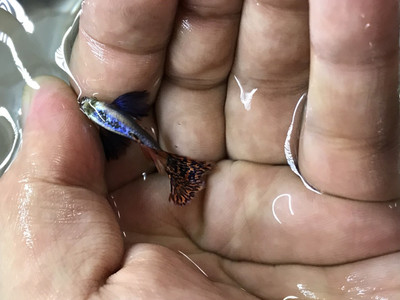Dumbo Guppy (Poecilia reticulata)
Posted by Max Gandara on on 25th Sep 2024
Dumbo Guppy (Poecilia reticulata)
Origin and Habitat:
The Dumbo Guppy, a striking variation of the common guppy (Poecilia reticulata), originates from South America. Wild guppies are native to countries such as Venezuela, Brazil, and Trinidad, where they inhabit slow-moving rivers, streams, and pools with dense vegetation. In the wild, guppies are accustomed to warm, slightly brackish waters with plenty of plant life to hide and feed.
Appearance:
Dumbo Guppies are named for their enlarged, fan-like pectoral fins, reminiscent of elephant ears, which give them a distinctive and elegant appearance. They come in a variety of colors, with males typically displaying more vivid hues than females. Their large pectoral fins add a graceful flow to their swimming, making them a captivating addition to any aquarium. Dumbo Guppies are small fish, growing to about 1.5 to 2 inches (3.8 to 5 cm) in length.
Aquarium Care:
Dumbo Guppies are hardy fish that can adapt to a wide range of water conditions, making them an excellent choice for both beginner and experienced aquarists.
- Tank Size: A tank of at least 10 gallons is recommended for a small group of guppies. These fish are active swimmers, so larger tanks with more space are always better, especially if housing multiple guppies.
- Water Parameters: Dumbo Guppies thrive in temperatures between 72°F to 82°F (22°C to 28°C) with a pH level of 7.0 to 8.2. They prefer hard water, and adding some aquarium salt can mimic the slightly brackish conditions they may encounter in the wild.
- Diet: Guppies are omnivores and should be fed a varied diet to maintain vibrant colors and health. High-quality flakes, pellets, and live or frozen foods such as brine shrimp, daphnia, and bloodworms are ideal for them. They also appreciate plant-based foods like spirulina.
- Behavior and Temperament: Dumbo Guppies are peaceful, social fish that thrive in groups. Keeping them in a ratio of one male to two or three females is recommended to prevent males from harassing females too much during breeding attempts. They are compatible with other peaceful species like tetras, rasboras, and small catfish.
Aquarium Setup:
A well-planted tank with live plants like Java moss, Anubias, and floating plants will mimic their natural habitat and provide hiding spaces for females and fry. These guppies are not strong swimmers despite their activity level, so the water flow should be gentle. Adding decorations like driftwood and rocks will also enhance the aesthetics of the tank while offering additional cover.
Breeding:
Dumbo Guppies are livebearers, meaning they give birth to free-swimming fry rather than laying eggs. They breed easily in home aquariums, and females can give birth every 30 days. To protect the fry from being eaten by adults, it's essential to provide plenty of hiding spaces or use a breeding box. Fry can be fed with specialized fry food or finely crushed flakes.
Lifespan:
With proper care, Dumbo Guppies can live for 2 to 3 years. Maintaining good water quality and a balanced diet is key to their longevity.
Conclusion:
The Dumbo Guppy is a visually stunning and easy-to-care-for fish that can bring both color and personality to any aquarium. Their peaceful nature and hardiness make them suitable for community tanks, and their unique large fins add a captivating aesthetic to the tank. Whether you're a beginner or a seasoned hobbyist, the Dumbo Guppy is a delightful species that can thrive in a variety of setups.

